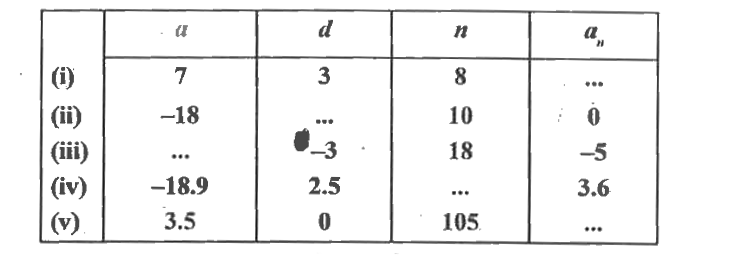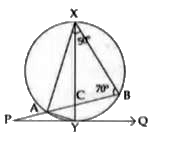Show that a1,a2,….,an,… form an A.P where an is defined as below : (i) an=3+4n (ii) an=9−5n.
Also find the sum of the first 15 terms in each case.Solution in Kannada
The correct Answer is:(i) S15=525
(ii) S15=−465.
Step by step video, text & image solution for Show that a_(1), a_(2), ….,a_(n),… form an A.P where an is defined as below : (i) a_(n) = 3 + 4n (ii) a_(n) = 9 - 5n. Also find the sum of the first 15 terms in each case. by Maths experts to help you in doubts & scoring excellent marks in Class 10 exams.
Updated on:21/07/2023Topper's Solved these Questions
- ARITHMETIC PROGRESSIONSBOOK - ZEN PUBLICATIONCHAPTER - ARITHMETIC PROGRESSIONSEXERCISE - TEXTUAL EXERCISE (Exercise 1.4)
5 Videos
- ARITHMETIC PROGRESSIONSBOOK - ZEN PUBLICATIONCHAPTER - ARITHMETIC PROGRESSIONSEXERCISE - ZEN ADDITIONAL QUESTIONS (MULTIPLE-CHOICE QUESTIONS [MCQS] )
17 Videos
- ARITHMETIC PROGRESSIONSBOOK - ZEN PUBLICATIONCHAPTER - ARITHMETIC PROGRESSIONSEXERCISE - TEXTUAL EXERCISE (Exercise 1.2)
20 Videos
- AREA RELATED TO CIRCLES BOOK - ZEN PUBLICATIONCHAPTER - AREA RELATED TO CIRCLES EXERCISE - ADDITIONAL QUESTIONS (HIGHER ORDER THINKING SKILLS)
7 Videos
- CIRCLESBOOK - ZEN PUBLICATIONCHAPTER - CIRCLESEXERCISE - ZEN ADDITIONAL QUESTIONS ( HOT [HIGHER ORDER THINKING SKILLS] - QUESTIONS) (IIT AND IMO)
9 Videos
Similar Questions
Which term of the A.P.: 121,117,113,..... is its first negative term?
View SolutionThe first nth term of a AP is given by
View SolutionFill in the blanks in the following table, given that a is the first term, d the common difference and an nth term of the AP :

View SolutionFind the area of the shaded region portion in the given figure if E is the midpoint of AB,AGE and BEF are quadrants, and DOC is a semicircle.

View SolutionIn the adjoining figure, XY is a diameter of the circle and PQ is a tangent to the circle at Y. Given that ⌊AXB=50∘ and ⌊ABX=70∘, calculate ⌊BAY and ⌊APY.

View SolutionShow that a1,a2,...,an,...form an AP where anis defined as below : (i) an=3+4n (ii) an=9−5n. Also find the sum of the first 15 terms in each case.
View SolutionFind the indicated terms in each of the following sequences whose nth terms are: an=5n−4;a12anda15 an=3n−24n+5;a+7anda8 an=n(n−1);a5anda8 an=(n−1)(2−n)3+n);a1,a2,a3 an=(−1)n;a3,a5,a8
View Solutionदर्शाइए की a1,a2,……an,…… से एक A.P. बनती हैं, यदि an नीचे दिए अनुसार परिभाषित हैं :
(i)an=3+4n(ii)an=9−5n
साथ ही, प्रत्येक स्थिति में, प्रथम 15 पदों का योग ज्ञात कीजिए ।
View Solutionदर्शाइए कि a1,a2,a3,...,an,.. से एक स. श्रे. बनती है यदि an नीचे दिए अनुसार परिभाषित है :
(i) an=3+4n , (ii) an=9−5n
साथ ही प्रत्येक स्थिति में प्रथम 15 पदों का योग ज्ञात कीजिए ।
View SolutionShow that a1,a2,……..,an….. form an AP where an is defined as below:
(i) an=3+4n. Also find the sum of the first 15 terms in each case.
View Solutionnth term of an A.P. is an. If a1+a2+a3=102 and a1=15, then find a10.
View SolutionShow that a1,a2,….,an,… form an A.P where an is defined as below : (i) an=3+4n (ii) an=9−5n.
Also find the sum of the first 15 terms in each case.
View Solutionयदि an=9−5n हो तो a1,a2,d एवं प्रथम 15 पदों का योग ज्ञात करें |
View SolutionWrite the fourth term in the sequence, defined as below:
(i) an=5n−2
View SolutionFind the terms indicated in each case:
(i) an=4n−3,a17,a24
(ii) an=(n−1)(2−n)(3+n),a1,a2,a3
View SolutionShow that a1,a2,……, an…. Form an AP where an is defined as below:
(i) an=3+4n, (ii) an=9−5n
Also find the sum of the first 15 terms in each case.
View Solution
